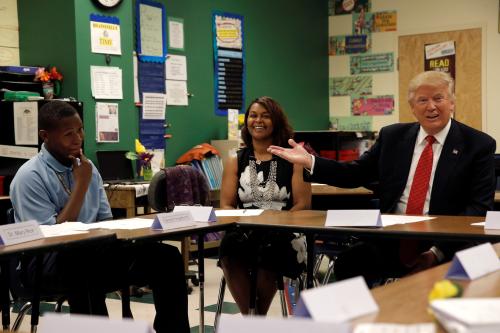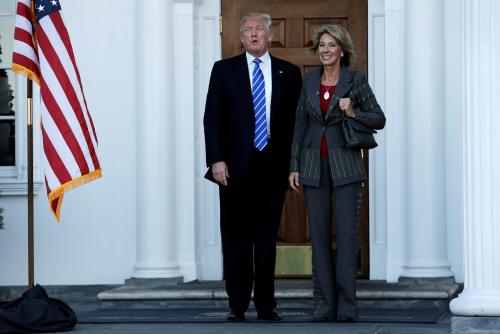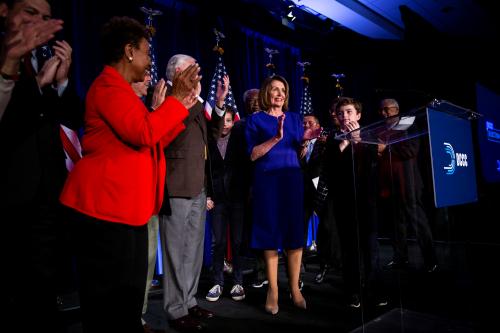President Donald Trump’s proposed education budget is an agglomeration of bold and at times contradictory policy positions, some of which have would-be Republican allies shaking their heads. Here, I highlight three salient features of this budget and discuss responses from the left and the right. As many have noted, several of the proposed cuts are unpopular on both sides of the aisle, suggesting that the final budget may deviate substantially from this proposal. (For a comprehensive overview of the education budget, see the White House budget document here, the Department’s summary here, and EdWeek’s coverage here.)
1. Title I funding’s future is unclear
Since initial passage of the Elementary and Secondary Education Act of 1965, the Title I program to provide funds to school districts with high concentrations of students from low-income families has been the bedrock of federal spending on K-12 education. Title I funds are distributed by a formula grant, and Title I is the largest K-12 program administered by the Department of Education. Large cuts here would be felt by school districts—and House members representing those districts—across the country.
It is no surprise, then, that the Trump administration did not propose major cuts here. However, determining the budget proposal’s implications for Title I funding is complicated. The proposal adds a new program under Title I, Furthering Options for Children to Unlock Success (FOCUS), with a proposed budget of 1 billion dollars. FOCUS would fund state school choice programs by providing “supplemental awards to school districts that agree to adopt weighted student funding combined with open enrollment systems that allow Federal, State, and local funds to follow students to the public school of their choice.”
The federal government would not distribute FOCUS funds using the standard Title I formula, raising the question of whether this proposed budget increase should be considered an increase in Title I funds. Further complicating matters, Congress passed two budget laws in 2017–whether funding for Title I appears to increase or decrease in Trump’s budget depends on whether you compare his proposal to the 2017 annualized Continuing Resolution (CR) signed December 2016, or the 2017 fiscal year appropriation signed May 2017. As the figure below shows, compared to either 2017 budget law, Title I funds would increase in fiscal year 2018 if you include FOCUS funds. Omitting FOCUS funds, Title I funding is level compared to the 2017 CR but decreases compared to the 2017 fiscal year appropriation.
Depending on what set of numbers one uses, it is thus possible to claim that proposed Title I funds are the same, higher, or lower than in 2017. This issue led to partisan sparring over how the Trump budget proposal could affect Title I, the central federal funding stream for K-12 education. In the June 6 Senate hearing on the budget, for example, Sen. Patty Murray (D-Wash.) and Education Secretary Betsy DeVos disagreed over whether the proposed budget would maintain or decrease Title I spending.
In addition to concerns about funding levels, observers note that the FOCUS program, which is not mandated through legislation, requires states to adopt policies favored by DeVos and her department in order to receive federal funds. Sen. James Lankford (R-Okla.) expressed his concern to DeVos that this approach echoes the Obama administration’s strategy under Race to the Top, which ultimately aggravated many state education leaders who found this approach prescriptive.
2. Proposed higher education cuts could be substantial
The Trump administration has proposed a number of cuts to higher education spending, including eliminating the Public Service Loan Forgiveness program. They have also proposed an unusually large cut to the federal work study program. According to the Office of Federal Student Aid, this program “provides part-time jobs for undergraduate and graduate students with financial need, allowing them to earn money to help pay education expenses.” If federal work study is funded at the proposed level, it would be the lowest level of funding the program has ever received since the Department of Education began to administer it in 1980, reflected in the figure below. It is also one of the biggest proposed cuts compared to the prior year’s budget request.
The Trump budget also proposes a decrease in Career and Technical Education funding. As the figure below shows, the proposed budget for this program has jumped around in recent years. The actual appropriation levels have been quite stable post-recession. During the House budget hearing, DeVos urged “schools to look at successful career and technical education programs run by states and districts and find ways to scale up and implement those.” However, this advice may ring hollow in states facing budget shortfalls. And while these proposed cuts in higher education align with traditional Republican preferences for reducing federal spending, the size of the proposed work study cut in particular is dramatic compared with recent budget proposals from Democratic and Republican presidents alike.
3. Office of Civil Rights spared
The Trump budget proposes level funding for the Office of Civil Rights (OCR), which may have surprised Democrats who worry that OCR will play a diminished role in this administration. The joint repeal with the Department of Justice of the Obama administration’s guidance on bathroom access for transgender students, for example, signaled a retreat from the previous administration’s approach in this arena. Since her confirmation hearing, DeVos has not offered much clarity on how she views the Department of Education’s role in enforcing civil rights laws. Recently, in both the House and Senate hearings on the budget, Democrats have pressed her to affirm her commitment to protecting students’ civil rights, particularly in the context of school choice programs.
This level funding proposal might reflect an awareness that decreasing the OCR budget would only provide additional fodder for Democrats to criticize DeVos’s commitment to enforcing federal civil rights laws. Nonetheless, the department has sent mixed signals about its intentions regarding the direction of civil rights enforcement, and it remains difficult to say what DeVos’s philosophy is regarding what exactly this responsibility entails.
Budget proposal faces criticism from both Democrats and Republicans
While the scale of the proposed cuts is dramatic and perhaps surprising–a 13.5 percent reduction in funding overall–the budget reflects many of the priorities DeVos has articulated from early on in her tenure. In particular, a consistent theme is her emphasis on state flexibility. During her confirmation and in recent House and Senate committee hearings on the budget, DeVos frequently described a desire to grant states increased flexibility as the motivation for her department’s policy positions and budget proposals.
Democrats and Republicans alike embraced this concept in the bipartisan Every Student Succeeds Act, but judging by their questions during the recent budget hearings, Democrats are weary of DeVos justifying her agenda under the banner of flexibility. And although Republicans consistently champion state flexibility in the administration of public education and federal cost saving generally, the proposed cuts seem to be a bridge too far. Indeed, during the Senate subcommittee hearing on Tuesday, chairman Roy Blunt (R-Mo.) told DeVos: “This is a difficult budget request to defend.”
Correction: This post previously stated that “Title I is the largest program administered by the Department of Education”; it should have read, “Title I is the largest K-12 program administered by the Department of Education.”







Commentary
3 observations on Trump’s education budget
June 7, 2017